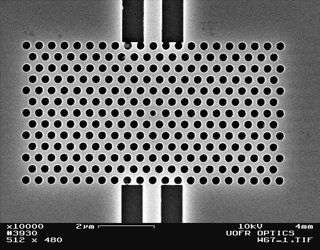December 20, 2007 feature
'Nanocavity' Sensor Detects Virus-Sized Particles

Scientists have created a nanoscale device that is capable of detecting one quadrillionth of a gram of biological matter, or about the size of certain viruses. In the future, the sensor may be able to detect influenza, severe acute respiratory syndrome (SARS), bird flu, and other viruses.
The sensor was created by researchers from the University of Rochester in Rochester, New York, and is described in a recent edition of Optics Letters.
The sensor is a hexagonal array of tiny cavities, each 240 nanometers in diameter, carved into a very thin slab of silicon using a beam of electrons. It has a total sensing area of about 40 micrometers square, making it one of the smallest sensors of its type.
When a laser beam is directed into the crystal, it interacts with the crystal such that only a particular part of the light's spectrum is transmitted. But when a particle is trapped in one of the nanocavities, the transmitted spectrum changes slightly. A detector measures the altered spectrum.
“When a virus within a certain size range is caught in one of the nanocavities, the sensor transmits a light spectrum that is slightly different than the spectrum it transmits when no particles are present,” said University of Rochester engineer Philippe Fauchet, the project's corresponding researcher, to PhysOrg.com. “We can then compare the two spectra to determine whether the target particle was captured, which forms the basis for a very simple yet powerful biosensor that could be used by untrained personnel, such as front-line health care providers.”
Fauchet and co-researcher Mindy Lee watched the sensor successfully detect single latex “test” spheres with sizes comparable to a variety of viruses. These include influenza A (approximately 100 nanometers in diameter) and hepatitis (50 nanometers in diameter). With a few modifications, Fauchet and Lee say that the device will be able to move from latex spheres to actual viruses.
The sensor is classified as a “two-dimensional photonic crystal,” a type of nanostructure that causes photons to behave in a similar way as a semiconductor causes electrons to behave. That is, only photons having frequencies within a certain range can be transmitted through the crystal, much like how electrons can only move through a semiconductor if they have certain energies.
“One dimensional” silicon-based photonic crystals, which are very, very thin, have been used to detect DNA, proteins, and bacteria. However, they only work properly if the laser beam is well collimated (the rays are nearly parallel). In turn, this requires that the sensing area is relatively large, which is not the desired trend. Fauchet and Lee's device removes these restrictions.
Citation: Optics Letters / Vol. 32, No. 22 / November 15, 2007
Copyright 2007 PhysOrg.com.
All rights reserved. This material may not be published, broadcast, rewritten or redistributed in whole or part without the express written permission of PhysOrg.com.





















